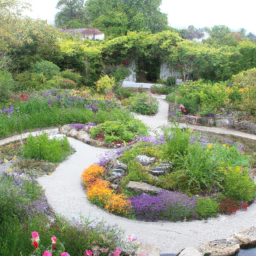Introduction
Landscaping is not just about beautifying the outdoors; it is a reflection of our history, culture, and the ever-evolving relationship between humans and nature. The saga of landscaping is a journey through time and gardens, from the ancient world to the present day, encompassing various styles, techniques, and philosophies. This article aims to take you on this journey, offering a glimpse into the fascinating world of landscaping and its impact on our lives.
Ancient Civilizations
The roots of landscaping can be traced back to ancient civilizations, such as Egypt, Mesopotamia, Persia, and Greece. Gardens were an integral part of these societies, often serving as places for relaxation, reflection, and spiritual connection. The Egyptians built walled gardens with rows of trees and ponds, while the Mesopotamians developed the famous "hanging gardens." In Persia, the concept of "paradise gardens" was born, characterized by lush greenery, water features, and intricate designs.
Greek and Roman Influence
The Greeks and Romans took landscaping to a new level, incorporating it into their architecture and city planning. Greek gardens often included sacred groves, while Roman gardens were more elaborate, featuring terraces, topiaries, and elaborate water features. Roman villas often had large gardens, both for practical purposes, such as growing food, and for leisure, such as the famous Villa of the Mysteries in Pompeii.
The Middle Ages
During the Middle Ages, European gardens took on a more functional role, primarily serving as sources of food and medicine. Monastic gardens were particularly influential, as monks cultivated plants for both practical and spiritual purposes. However, the concept of ornamental gardens began to emerge as well, with castles and manor houses featuring gardens designed for leisure and entertainment, such as the famous gardens of the Alhambra in Spain.
The Renaissance
The Renaissance period marked a turning point in the history of landscaping, as gardens became a form of art and a symbol of wealth and status. The Italian Renaissance garden, characterized by symmetry, geometry, and the use of water features, sculptures, and grottoes, had a significant influence on European landscaping. Notable examples include the gardens of Villa d'Este, Villa Lante, and the Boboli Gardens.
The Baroque and Rococo Periods
The Baroque and Rococo periods saw the development of more extravagant and theatrical gardens, with a focus on grandeur, illusion, and surprise. French formal gardens, such as those at the Palace of Versailles, epitomize this style, featuring elaborate fountains, parterres, and topiaries. The English landscape garden, on the other hand, sought to create a more naturalistic and picturesque setting, as seen in the gardens of Stourhead and Stowe.
The 19th Century
The 19th century brought about a shift towards more informal and naturalistic garden designs, as well as a renewed interest in horticulture and exotic plants. The Victorian era saw the rise of the "gardenesque" style, characterized by the use of colorful and exotic plants, winding paths, and elaborate garden ornaments. This period also saw the development of public parks and gardens, such as Central Park in New York City and the Royal Botanic Gardens in Kew, England.
The 20th Century and Beyond
In the 20th century, modernism and the influence of the Arts and Crafts movement led to a more minimalist and functional approach to landscaping. The concept of the "modern garden" emerged, with an emphasis on clean lines, simple forms, and the use of local materials. However, the late 20th and early 21st centuries have also seen a resurgence of interest in traditional garden styles and techniques, as well as a growing awareness of the importance of sustainable and ecological landscape design.
Cultural Influences
Throughout history, landscaping has been influenced by various cultures and traditions. For example, Japanese and Chinese gardens have had a significant impact on Western garden design, with their emphasis on simplicity, balance, and the integration of natural elements. Islamic gardens, with their focus on water and shade, have also played a crucial role in shaping the history of landscaping.
The Role of Landscape Architects
Landscape architects have played a vital role in the evolution of landscaping, blending art, science, and environmental stewardship to create beautiful and functional outdoor spaces. Notable landscape architects include Capability Brown, Frederick Law Olmsted, Gertrude Jekyll, and Roberto Burle Marx.
The Future of Landscaping
As we look to the future, the importance of sustainable and environmentally-friendly landscaping practices will continue to grow. Climate change, urbanization, and the loss of biodiversity are all issues that landscape architects and gardeners must address in their work. Green roofs, urban agriculture, and the use of native plants are all trends that are shaping the future of landscaping.
Conclusion
The saga of landscaping is a fascinating journey through time and gardens, revealing the ever-evolving relationship between humans and nature. As we continue to face environmental challenges and adapt to new technologies, the world of landscaping will undoubtedly continue to evolve and innovate, offering endless possibilities for the creation of beautiful, functional, and sustainable outdoor spaces.
